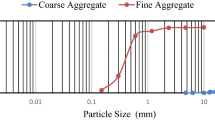Abstract
The development of modern civil construction has created a significant demand for concrete, which must characterize increased qualities, such as high compressive strength, flexural strength, impact resistance. While concrete is designed primarily to withstand structural loads, it must also contend an array of environmental effects, which determines its durability. The paper is presented the investigation results of the durability of modified high strength fiber-reinforced concrete under the dry-wet cycles effect, which can occur both under the weathering and human activities influence (car washes, industrial floors etc.). The analysis criteria were deterioration in compressive strength and impact resistance of concrete. The compressive strength of developed concrete after 100 dry-wet cycles decreases by 1.9–2.8%. Dispersed reinforcement with polypropylene fiber provided an effective increase in resistance to impact loads under the combined effect of dry-wet cycles. The impact strength of modified high strength fiber-reinforced concrete after 50 and 100 dry-wet cycles decreases by 2.2–3.4% and 3.1–5.4% respectively.
Access this chapter
Tax calculation will be finalised at checkout
Purchases are for personal use only
Similar content being viewed by others
References
Miller SA, Moore FC (2020) Climate and health damages from global concrete production. Nat Clim Chang 10:439–443
Van den Heede P, De Belie N (2014) A service life based global warming potential for high-volume fly ash concrete exposed to carbonation. Constr Build Mater 55:183–193
Murali G, Santhi AS, Mohan Ganesh G (2014) Impact resistance and strength reliability of fiber-reinforced concrete in bending under drop weight impact load. Int J Technol 5(2):111–120
Zhang J, Gao Y, Han Y (2012) Interior humidity of concrete under dry-wet cycles. J Mater Civ Eng 24:289–298
Liu F, Zhang T, Luo T, Zhou M, Zhang K, Ma W (2020) Study on the deterioration of concrete under dry-wet cycle and sulfate attack. Materials 13:4095
Wang K, Guo J, Liu X (2021) Effect of dry–wet ratio on pore-structure characteristics of fly ash concrete under sulfate attack. Mater Struct 54:100
Guo J-J, Liu P-Q, Wu C-L, Wang K (2021) Effect of dry-wet cycle periods on properties of concrete under sulfate attack. Appl Sci 11:888
Marushchak U, Sydor N, Braichenko S, Margal I, Soltysik R (2019) Modified fiber reinforced concrete for industrial floors. In: IOP conference series: materials science and engineering vol 708/1, p 012094
Vybranets Y, Vikhot S (2023) Spatial calculation of metal truss structure in joint work with reinforced concrete slab. Lect Notes Civil Eng 290:450–458
Sanytsky M, Usherov-Marshak A, Marushchak U, Kabus A (2021) The effect of mechanical activation on the properties of hardened Portland cement. Lect Notes Civil Eng 100:378–384
Chepurna S, Borziak O, Zubenko S (2019) Concretes, modified by the addition of high-diffused chalk, for small architectural forms. Mater Sci Forum 968:82–88
Markiv T, Sobol K, Petrovska N, Hunyak O (2020) The effect of porous pozzolanic polydisperse mineral components on properties of concrete. Lect Notes Civil Eng 47:275–282
Hunyak O, Hidei V, Sobol K, Petrovska N (2023) Valorization of wastepaper sludge ash as supplementary cementitious material in concrete. Lect Notes Civil Eng 290:94–100
Shamsad A, Baghabra Al-Amoudi OS, Khan SMS, Maslehuddin M (2022) Effect of silica fume inclusion on the strength, shrinkage and durability characteristics of natural pozzolan-based cement concrete. Case Stud Constr Mater 17:01255
Sanytsky M, Kropyvnytska T, Heviuk I, Sikora P, Braichenko S (2021) Development of rapid hardening ultra-high strength cementitious composites using superzeolite and N-C-S-H-PCE alkaline nanomodifier. Eastern-Eur J Enterp Technol 5(6):62–72
Stechshyn M, Sanytsky M, Poznyak O (2015) Durability properties of high volume fly ash self-compacting fiber reinforced concretes. Eastern-Eur J Enterp Technol 3(11):49–53
Krishna A, Mohan Kaliyaperumal SR, Kathirvel P (2022) Compressive strength and impact resistance of hybrid fiber reinforced concrete exposed to elevated temperatures. Struct Concr 23:3
Marushchak U, Sanytsky M, Sydor N, Braichenko S (2018) Research of impact resistance of nanomodified fiber reinforced concrete. MATEC Web Conf 230:03012
Najaf E, Abbasi H (2022) Impact resistance and mechanical properties of fiber-reinforced concrete using string and fibrillated polypropylene fibers in a hybrid form. Struct Concr 24:10
Mohtasham Moein M et al (2022) Investigation of impact resistance of high-strength Portland cement concrete containing steel fibers. Materials 15:7157
Marushchak U, Sanytsky M, Sydor N, Braichenko S (2018) Research of nanomodified engineered cementitious composites. In: Proceedings of the 2018 IEEE 8th international conference on nanomaterials: applications and properties, p 8914835
Sydor N, Marushchak U, Braichenko S, Rusyn B (2021) Development of component composition of engineered cementitious composites. Lect Notes Civil Eng 100:459–465
Marushchak U, Sydor N, Margal I (2023) Impact of polypropylene fibers on the properties of engineered cementitious composites. Lect Notes Civil Eng 290:262–269
Turba Y, Solodkyy S (2021) Crack resistance of concretes reinforced with polypropylene fiber. Lect Notes Civil Eng 100:474–481
Vyrovoy V, Korobko O, Antoniuk N, Zakorchemny Y (2021) Influence of cracks on the safe functioning of building structures. Mater Sci Forum MSF 1038:383–392
Author information
Authors and Affiliations
Corresponding author
Editor information
Editors and Affiliations
Rights and permissions
Copyright information
© 2024 The Author(s), under exclusive license to Springer Nature Switzerland AG
About this paper
Cite this paper
Marushchak, U., Sydor, N., Braichenko, S., Hohol, M. (2024). Effect of Dry–Wet Cycles on Properties of High Strength Fiber-Reinforced Concrete. In: Blikharskyy, Z., Koszelnik, P., Lichołai, L., Nazarko, P., Katunský, D. (eds) Proceedings of CEE 2023. CEE 2023. Lecture Notes in Civil Engineering, vol 438. Springer, Cham. https://doi.org/10.1007/978-3-031-44955-0_27
Download citation
DOI: https://doi.org/10.1007/978-3-031-44955-0_27
Published:
Publisher Name: Springer, Cham
Print ISBN: 978-3-031-44954-3
Online ISBN: 978-3-031-44955-0
eBook Packages: EngineeringEngineering (R0)




